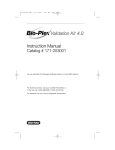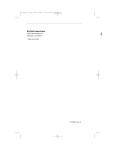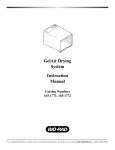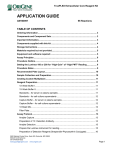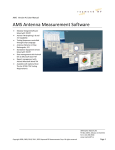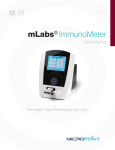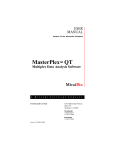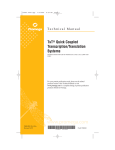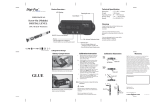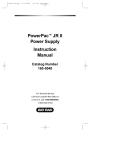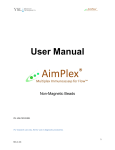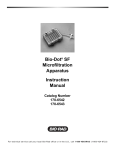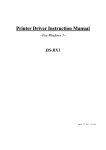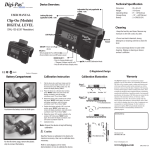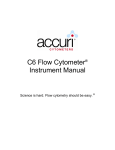Download - Bio-Rad
Transcript
4110185B.qxp 9/25/2007 11:55 AM Page CVR1 Instruction Manual Catalog # 171-203001 For use with Bio-Plex Manager™ software version 5.0 and higher with MCV plate IV, or for use with Bio-Plex Manager software 4.0/4.1 with MCV plate III. For technical support, contact your local Bio-Rad office or, in the US, call 1-800-4BIORAD (1-800-424-6723) For research use only. Not for diagnostic procedures. 4110185B.qxp 9/25/2007 11:55 AM Page I Table of Contents Section 1 Introduction . . . . . . . . . . . . . . . . . . . . . . . . . . . . . . . .1 Section 2 Product Description . . . . . . . . . . . . . . . . . . . . . . . . . .2 Section 3 Specifications . . . . . . . . . . . . . . . . . . . . . . . . . . . . . . .3 Section 4 Storage and Handling . . . . . . . . . . . . . . . . . . . . . . . . .3 Section 5 Principle of Optics Validation . . . . . . . . . . . . . . . . . . .3 Section 6 Principle of Reporter Validation . . . . . . . . . . . . . . . . .4 Section 7 Principle of Classify Validation . . . . . . . . . . . . . . . . . .7 Section 8 Principle of Fluidics Validation . . . . . . . . . . . . . . . . . .8 Section 9 Software Utility Installation . . . . . . . . . . . . . . . . . . . .8 Section 10 Procedure for Performing Validation . . . . . . . . . . . . .9 10.1 One-Step Procedure for all Validation Parameters . . . . . . . . . .9 10.2 Validation of Optics Alignment . . . . . . . . . . . . . . . . . . . . . . . .12 10.3 Validation of Fluidics Integrity . . . . . . . . . . . . . . . . . . . . . . . .14 10.4 Validation of Reporter Channel Performance . . . . . . . . . . . . .15 10.5 Validation of Classify Efficiency . . . . . . . . . . . . . . . . . . . . . . .17 10.6 Generating a Validation Report . . . . . . . . . . . . . . . . . . . . . . .18 10.7 Validation Kit Report Form Example . . . . . . . . . . . . . . . . . . .19 Section 11 Troubleshooting Guide . . . . . . . . . . . . . . . . . . . . . . .21 Section 12 Ordering Information . . . . . . . . . . . . . . . . . . . . . . . .21 Section 13 Reference . . . . . . . . . . . . . . . . . . . . . . . . . . . . . . . . .22 4110185B.qxp 9/25/2007 11:55 AM Page 1 Section 1 Introduction Qualification of analytical instruments is a formal process of documenting that an instrument is fit for its intended use and that it is kept maintained and calibrated. The Bio-Plex® validation kit is used for operational qualification (OQ) of the Bio-Plex suspension array system. The validation kit is designed to validate the operation of all of the primary components of the system and is a valuable tool that allows the user to discriminate between assay and instrumentation problems. The Bio-Plex validation kit consists of beads to evaluate the following components of the Bio-Plex suspension array system: 1) optics alignment, 2) integrity of fluidics, 3) reporter channel performance, and 4) classify efficiency. A brief definition of the parameter and the principle of each procedure is described, along with complete procedures for evaluating each of the primary components. An explanation of the potential impact of each process on a typical Bio-Plex cytokine assay is included to assist the user in assay troubleshooting and development. 1 4110185B.qxp 9/25/2007 11:55 AM Page 2 Section 2 Product Description The following reagents are included in the Bio-Plex® validation kit 4.0: Reagent Optics validation bead set: Optics beads 1 and 2 (1x105 beads/ml) Quantity 2 x 10 ml black bottles Fluidics validation bead set: Fluidics bead 1 and 2 (1x105 beads/ml) 2 x 10 ml black bottles Reporter validation bead set: Reporter blank, 1, 2, 3, 4, 5, and 6 (1x105 beads/ml) 6 x 10 ml white bottles Classify validation bead set: Classify bead A(1), B(4), C(40), D(54), E(100) (1x105 beads/ml) 5 x 10 ml black bottles Note: The Bio-Plex validation kit also includes a BizCard CD, which contains lotspecific product specifications. The following materials are required but not supplied: Bio-Plex MCV plates Bio-Rad catalog #171-203032, MCV plate III, for use with Bio-Plex Manager 4.0/4.1 (standard or security software) Bio-Rad catalog #171-203033, MCV plate IV, for use with Bio-Plex Manager 5.0 and later (standard or security software) Bio-Plex Suspension Array System Bio-Rad catalog #171-000001, 171-000002, 171-000003, 171-00004, 171-000005, 171-000006, 171-000007, or 171-000009 Bio-Plex Calibration Kit Bio-Rad catalog #171-203060, includes Cal1 and Cal2 calibration beads for approximately 50 daily calibration routines mini vortexer sterile distilled water 70% isopropanol 10% bleach bulb pipets 2 4110185B.qxp 9/25/2007 11:55 AM Page 3 Section 3 Specifications Specifications for the Bio-Plex® validation kit may differ from lot to lot. Please refer to the package insert provided with your validation kit for specifications. Section for Software Installation The Bio-Plex validation kit 4.0 includes a BizCard CD containing files with the specifications for the validation beads along with additional information. The file information is automatically loaded into Bio-Plex Manager™ 4.0 and later versions upon installation. Section 4 Storage and Handling The Bio-Plex® validation kit beads are stable if stored at 4°C protected from light. When using the Bio-Plex validation kit, remove beads from storage and dispense into the MCV plate. Return to 4°C storage immediately following use to preserve shelf life. All components are guaranteed for 18 months from the date of manufacture when stored as specified in this manual. Section 5 Principle of Optics Validation Principle The Bio-Plex® array reader is a laser-based fluorescence detection system containing sensitive optics components. Alignment of the laser/optics system is critical for optimal instrument performance. A method for the assessment of the optics alignment is included in the validation kit. Acceptable specifications for the alignment procedure are listed in the product insert. Impact on Assay Performance The alignment of the optics bench of the Bio-Plex array reader is critical for proper assay performance. Misalignment of the reporter optics path can result in 1) reduced assay sensitivity or 2) poor well-to-well assay precision. Misalignment of the classification optics path can lead to 1) increased read times or 2) misclassification of one assay into another, leading to false positive or negative results. Correlation studies have been performed to determine the direct effect of misalignment on assay performance. 3 4110185B.qxp 9/25/2007 11:55 AM Page 4 Section 6 Principle of Reporter Validation Principle The reporter (RP1) channel is the fluorescence channel used for assay quantitation (See Bio-Plex® system hardware manual for more information regarding the principle of Bio-Plex technology). Therefore, validation of this component of the Bio-Plex system is a critical part of operational qualification. R-phycoerythrin (R-PE) is the primary reporter molecule used in Bio-Plex assays. A series of beads dyed with varying intensities of a fluorochrome spectrally matched to R-phycoerythrin are used for this procedure. The primary reporter channel performance parameters are as follows: dynamic range, linearity, slope, accuracy, and instrument threshold (sensitivity) of the reporter channel response. Each of these parameters is related directly to the performance of the Bio-Plex array reader and has defined acceptable specifications. Definitions for the parameters and the applicability to a typical assay performed on the Bio-Plex array reader are listed below. If any of the parameters are not within the specified range, contact Bio-Rad technical support for assistance. High Versus Low PMT Calibration and Validation Some assays may require quantitating a range of analyte concentrations greater than what can be achieved running the instrument at a single PMT setting. In these cases, the samples may be run with different detector channel PMT settings: a high RP1 target setting and a low RP1 target setting. They are set differently depending on your version of Bio-Plex Manager™ software. For Bio-Plex Manager 4.0/4.1, the targets are set during calibration of the instrument. Using the high RP1 target will allow for the ability to quantitate lower concentrations of analyte, while using the low RP1 target allows for the ability to quantitate higher concentrations of analyte. For Bio-Plex Manager 5.0 and later, calibration is performed using the low RP1 target and the high RP1 target is then selected during the validation setup. Dynamic Range of Reporter Channel Definition The theoretical maximum dynamic range of the Bio-Plex array reader can be represented by the maximum number of channels in the A/D converter. Currently, the available range of channels is from 0 to 32,767, or about 4.5 decades on a log scale. These channels are represented by FI, or Fluorescence Intensity units. The dynamic range of the Bio-Plex array reader is measured by taking the log of the fluorescence intensity value of the highest reporter bead minus the fluorescence intensity of the blank bead. This value is the calibrated dynamic range of the instrument and is always less than 4.5 log decades because the highest intensity bead in the validation kit that is read is less than 32,767 FI units, while the blank bead gives a reading that is greater than zero FI units. 4 4110185B.qxp 9/25/2007 11:55 AM Page 5 Impact on Assay Performance It is desirable for the range of the instrument to be greater than the range of the assay. In most experiments, the dynamic range of the assay is far less than that of the instrument. However, in some assays, the same or different analytes may be present in greater than 4.5 log differences in concentration. When this is the case, the sample can be rerun at different PMT settings to extend the overall dynamic range of the measurements. Linearity of Reporter Channel Definition The reporter validation bead set is utilized to construct a plot where the reporter channel median fluorescence intensity values are plotted against the corresponding expected fluorescent intensity values (as determined on an independent calibrated instrument). Instrument linearity is expressed as the coefficient of determination or R-squared (R2) value. Impact on Assay Performance The linearity of the instrument response may directly affect a typical standard or calibration curve in a Bio-Plex assay, thereby impacting the unknown values extrapolated from that curve. If the R2 value is not within acceptable limits, it may be necessary to realign the optics or check the response of the reporter photomultiplier tube. Accuracy of Reporter Channel Response Definition The accuracy of the reporter channel response is a more stringent measurement of the linearity than the R2 value. Simply stated, the accuracy of the reporter channel response is the percent difference that the regression line is away from the expected fluorescence intensity data point values. Impact on Assay Performance Since accuracy is also a measurement of the linearity of the instrument response, the same principles that apply to linearity also apply to accuracy of the reporter channel response. The accuracy data is evaluated in combination with optics alignment to determine if the Bio-Plex reader will perform according to specifications. It is possible for the accuracy value to fall out of specification before the linearity parameter. This is expected due to the fact that the accuracy parameter is a more sensitive measurement of linearity than the R2 value. These data are correlated with optics alignment data as well as assay performance to determine when the array reader will not perform according to specifications. Slope of the Reporter Channel Response Definition The slope of the regression line resulting from the plotting of reporter channel mean fluorescent values against expected relative fluorescence is related to the dynamic range of the instrument. The slope of the regression line is a function of the response of the reporter channel photomultiplier tube. 5 4110185B.qxp 9/25/2007 11:55 AM Page 6 Impact on Assay Performance The slope of the regression line is directly related to the dynamic range of the instrument. The slope yields direct information about the response of the photomultiplier tube. If the photomultiplier tube signal saturates at low fluorescence values, the dynamic range of the instrument is affected. The slope of the line impacts the dynamic range and the range, in turn, impacts the quantifiable range of an assay. Instrument Threshold (Sensitivity) Definition Every instrument has an inherent level of background noise. Noise can be attributed to the laser, the PMT, the amplification electronics or the fluidics. The instrument threshold (sensitivity) of the Bio-Plex array reader is one way to demonstrate noise of the system. It is defined as the reporter channel signal of a blank bead that contains no reporter dye. Impact on Assay Performance The instrument threshold level demonstrated using the Bio-Plex validation kit is a low fluorescence intensity value. The typical background or zero standard of a Bio-Plex cytokine assay falls at a median fluorescence intensity of ~100. This is a desired result, as the instrument threshold should not limit the assay sensitivity. If the instrument threshold is too close to zero, then a low assay signal may be masked; if too high, then the linearity and dynamic range may be compromised. 6 4110185B.qxp 9/25/2007 11:55 AM Page 7 Section 7 Principle of Classify Validation Principle Bio-Plex® technology relies on the ability of the Bio-Plex array reader to discriminate between assay beads impregnated with varying ratios of 2 fluorescent dyes. This is the concept whereby multiplexing within a single well may occur. The periodic evaluation of the classify efficiency is necessary to complete the Bio-Plex array reader qualification process. A series of beads with varying ratios of the classification dyes are analyzed on the Bio-Plex array reader and the efficiency of multiplexing is quantitated. A classify efficiency of >80% is required for optimal results. Doublet Discriminator (DD) efficiency is a measure of the percentage of the classify beads that fall within the DD gates. The DD gates are used to distinguish single beads from bead clusters, bead fragments or other small particles passing in front of the detector. Greater than 75% of the beads should fall within the gates for optimal results. Impact on Assay Performance Inefficient classification of beads may have several potential effects on an assay. If a bead region exhibits a classify efficiency of less than 80%, the read time of a 96-well plate may be increased. The Bio-Plex array reader tabulates a specified number of defined events in each region for each well sampled. If the percentage of beads within a specific region is low, the time required to count is increased, therefore the total time to read an entire plate is prolonged. Extremely prolonged assay read times could impact well-to-well precision, since the kinetics of a sandwich assay, for example, are not 100% stable over a period of several hours. Another potential impact of inefficient classification is the misclassification of one assay bead into another bead region. This could yield false positive or negative results for a particular assay. A DD efficiency of less than 75% may increase the read time of the assay and affect results in the same manner as a low classify efficiency. 7 4110185B.qxp 9/25/2007 11:55 AM Page 8 Section 8 Principle of Fluidics Validation Principle The fluidics system of the Bio-Plex® array reader requires routine maintenance to prevent clogging and other malfunctions. Strict adherence to the maintenance procedures is mandatory for optimal instrument performance. An assessment of the integrity of the fluidics is automatically performed in the fluidics validation procedure. In the fluidics validation test, a sample of beads is analyzed followed by a sample of buffer to assess the carryover of beads from one well to another. This procedure should be performed once per week to ensure that assay results are not adversely affected. The fluidics path, including the sample needle, must be completely free of debris and excess beads for optimal array reader performance. Impact on Assay Performance If a system is exhibiting a high level of carryover due to valve malfunction or a partially clogged sample needle, a significant percentage of beads may be carried over from one well to another. This phenomenon may adversely affect the median fluorescent intensity values. For example, if a well with a high median fluorescent intensity (FI) is read immediately prior to a well with a low median FI, the signal in the well with the low fluorescent intensity may shift upward. This phenomenon only occurs in extreme cases since the median fluorescent intensity statistic is robust and is not easily shifted by the introduction of a population of beads with a significantly different median FI. Section 9 Software Utility Installation Introduction This section provides instructions for installing the control number information from the BizCard CD contained in the validation kit into the Bio-Plex Manager™ database. The BizCard CD contains the control number, expiration date, and specifications for your validation kit. Procedure 1. Exit Bio-Plex Manager prior to proceeding. 2. Insert the BizCard-CD into the CD Rom drive of your computer. The installation program should start automatically. The application can also be launched through Windows Explorer by double clicking on the file “InstallControlNumbers.exe”. 8 4110185B.qxp 9/25/2007 11:55 AM Page 9 3. If the control numbers on the BizCard CD already exist in the database, you will receive the message that the control numbers are already installed and the program will exit. Click on the OK button and remove the BizCard CD. 4. If the control numbers on the BizCard CD are not found in the database, you will see a dialog asking you to press OK to install the control numbers with their specifications. Click on the OK button. A dialog box will appear informing you that control numbers installation is complete. You may now proceed with validation in Bio-Plex Manager using the current control number. 5. Section 10 Procedure for Performing Validation Introduction This section provides instructions for use of the Bio-Plex® validation kit 4.0 using either Bio-Plex Manager™ 4.0/4.1 software with MCV plate III or Bio-Plex Manager 5.0 and later with MCV plate IV. Either software version provides a fully automated validation routine that sequentially performs all the validation tests without further user intervention. To perform all validations in a single step, follow instructions in Section 10.1. If you wish to perform an individual validation routine, consult Sections 10.2–10.5. Note: In the following instructions all references to the MCV plate without specifying III or IV indicate the procedure is used for either configuration. All pictures are updated to reflect the newest MCV plate, but does not imply that there is any difference in performance. 10.1 One-Step Procedure for all Validation Parameters Procedure 1. Turn on the Bio-Plex array reader, microplate platform, and computer as specified in the Bio-Plex hardware and Bio-Plex Manager user manuals. 2. Perform start-up procedure as directed. 3. Calibrate Bio-Plex array reader using Cal1 and Cal2 beads found in the Bio-Plex calibration kit according to the Bio-Plex Manager software manual. Note: Be sure to calibrate immediately before validation. If you are using Bio-Plex Manager 4.0/4.1, use either the high or low RP1 target for Cal2 calibration depending on the type of assay being performed. If you are using Bio-Plex Manager 5.0, the calibration is done on low RP1 target. Selection of high RP1 target is done in the validation screen. 4. Remove all validation bead sets from 4°C storage and vortex each bottle for 30 sec. This is very important for proper validation. 9 4110185B.qxp 5. 9/25/2007 11:55 AM Page 10 In Bio-Plex Manager software, select Instrument from the main menu. Select Validation from the pull-down menu. The following dialog box will appear (Figure 1A): Fig. 1A. Main validation dialog. 6. Enter user name and control number. Select All. Select OK. The following dialog box will appear (Figure 1B): Fig. 1B. All validation dialog. 10 4110185B.qxp 7. 9/25/2007 11:55 AM Page 11 Place 5 drops of each bead into the respective wells on the MCV plate (see Figure 2 below or Figure 1B). Store beads at 4°C as soon as possible after use. Protect the beads from light. Fig. 2. MCV plate IV. 8. Select the Eject button in the dialog box to eject the plate holder. 9. Place the MCV plate in the microplate platform. 10. Select OK to begin all validation procedures. 11. When the procedure has completed, the results will be displayed in a dialog box, as shown in Figure 3: Fig. 3. Validation results. 11 4110185B.qxp 9/25/2007 11:55 AM Page 12 12. Check the results for each validation. If specifications are not met for any validation, repeat that validation. If the value again is not within the specification range, contact Bio-Rad technical support for assistance. 13. The following sections describe the steps for performing the individual validations (optics, fluidics, reporter, or classify). 14. Validation results are also logged into a validation log in Bio-Plex Manager. To access this log, select View from the main menu then Validation Log. Each type of validation is stored in a separate log for the purpose of tracking data over time. See the Bio-Plex Manager user manual for your software version for more information on using the validation log. 10.2 Validation of Optics Alignment Procedure 1. If not already done, follow the procedure for start-up and calibration of the Bio-Plex system. Note: Be sure to calibrate immediately before validation. If you are using Bio-Plex Manager 4.0/4.1, use either the high or low RP1 target for Cal2 calibration depending on the type of assay being performed. If you are using Bio-Plex Manager 5.0, the calibration is done on low RP1 target. Selection of high RP1 target is done in the validation screen. 2. Remove the optics validation bead set from 4°C storage and vortex each bottle for 30 sec. 3. Place 5 drops each of optics beads 1 and 2 into the respective wells on the MCV plate. 4. Store optics beads at 4°C as soon as possible after use. Protect the beads from light. 5. In Bio-Plex Manager software, select Instrument from the main menu. Select Validation from the pull-down menu. 6. Enter user name and control number. Select Optics. Select OK. The following dialog appears (Figure 4): 12 4110185B.qxp 9/25/2007 11:55 AM Page 13 Fig. 4. Optics validation dialog. 7. Select the Eject button in the dialog box to eject the plate holder. 8. Place the MCV plate in the microplate platform. 9. Select OK to begin the optics validation procedure. 10. When the procedure has been completed, the results will be displayed in a dialog box, as shown in Figure 5: Fig. 5. Optics validation results. 13 4110185B.qxp 9/25/2007 11:55 AM Page 14 10.3 Validation of Fluidics Integrity Procedure 1. If not already done, follow the procedure for start-up and calibration of the Bio-Plex system. Note: Be sure to calibrate immediately before validation. If you are using Bio-Plex Manager 4.0/4.1, use either the high or low RP1 target for Cal2 calibration depending on the type of assay being performed. If you are using Bio-Plex Manager 5.0, the calibration is done on low RP1 target. Selection of high RP1 target is done in the validation screen. 2. 3. Select Instrument, then Validation from the main menu and select Fluidics in the dialog box. Enter user name and control number. Select OK. The following dialog box will then appear (Figure 6): Fig. 6. Fluidics validation dialog. 4. Add 5 drops each of fluidics beads 1 and 2 to the designated wells on the MCV plate. 5. Select the Eject button in the dialog box to eject the plate holder. 6. Place the MCV plate in the microplate platform. 7. Select OK to begin the fluidics validation procedure. 8. When the procedure has been completed, results will appear in a dialog box, as shown in Figure 7: 14 4110185B.qxp 9/25/2007 11:55 AM Page 15 Fig. 7. Fluidics validation results. 9. If value is not within the specification range, repeat the procedure. If value again is not within the specification range, contact Bio-Rad technical support for assistance. 10.4 Validation of Reporter Channel Performance Procedure 1. If not already done, follow the procedure for start-up and calibration of the Bio-Plex system. Note: Be sure to calibrate immediately before validation. If you are using Bio-Plex Manager 4.0/4.1, use either the high or low RP1 target for Cal2 calibration depending on the type of assay being performed. If you are using Bio-Plex Manager 5.0, the calibration is done on low RP1 target. Selection of high RP1 target is done in the validation screen. 2. Remove the reporter validation bead set from 4°C storage and vortex each bottle for 30 sec. 3. Place 5 drops of each reporter bead into the corresponding reporter well labeled as Blank, 1, 2, 3, 4, 5, and 6 in the MCV plate. 4. Store reporter beads at 4°C as soon as possible after use. Protect the beads from light. 5. Fill the DI H2O and 70% isopropanol reservoirs. 6. Select Instrument from the main menu. Select Validation from the pull-down menu. A dialog will appear. Enter user name and control number. Select Reporter Validation. Select OK. The following dialog will appear (Figure 8): 15 4110185B.qxp 9/25/2007 11:55 AM Page 16 Fig. 8. Reporter validation dialog. 7. Select the Eject icon in the dialog box to eject the plate holder. 8. Place the MCV plate in the microplate platform. 9. Select OK to start the reporter validation procedure. 10. When the procedure is completed, values will appear in a dialog box, as shown in Figure 9: Fig. 9. Reporter validation results. 11. The results will also be logged into a validation log in Bio-Plex Manager software. See the Bio-Plex Manager user manual for your software version for more information on using the validation log. 16 4110185B.qxp 9/25/2007 11:55 AM Page 17 12. Repeat procedure if values are not within the specification range. If values are again not within acceptable specification ranges, contact Bio-Rad technical support for assistance. 10.5 Validation of Classify Efficiency Procedure 1. If not already done, follow the procedure for start-up and calibration of the Bio-Plex system. Note: Be sure to calibrate immediately before validation. If you are using Bio-Plex Manager 4.0/4.1, use either the high or low RP1 target for Cal2 calibration depending on the type of assay being performed. If you are using Bio-Plex Manager 5.0, the calibration is done on low RP1 target. Selection of high RP1 target is done in the validation screen. 2. Remove the classify validation bead set from 4°C storage and vortex each bottle for 30 sec. 3. Place 5 drops of each classify bead into the corresponding classify well labeled as A, B, C, D, and E in the MCV plate. 4. Store stock vials at 4°C as soon as possible after use. Protect beads from light. 5. Select Instrument from the main menu. Select Validation from the pull-down menu. 6. Enter the User name and select control number. Select Classify Validation. Select OK. The following dialog box will appear (Figure 10): Fig. 10. Classify validation dialog. 7. Select the Eject button to eject the plate holder. 8. Place the MCV plate on the microplate platform. 9. Select OK to start the classify validation procedure. 17 4110185B.qxp 9/25/2007 11:55 AM Page 18 10. When the procedure is completed, values will be displayed in a dialog box as shown below (Figure 11). The classify efficiency and DD efficiency results may be accessed in this view. Fig. 11. Classify validation results. 11. The results will also be logged into a validation log in Bio-Plex Manager software. To access this log, select View from the main menu then Validation Log. Each type of validation is stored in a separate log for the purpose of tracking data over time. See the Bio-Plex Manager software user guide for your version of software for more information on using the validation log. 12. If any values do not meet specifications, repeat the procedure. If values are again not within specifications, contact Bio-Rad technical service for assistance. 10.6 Generating a Validation Report Procedure The results from each validation procedure are sent to a validation log in Bio-Plex Manager software. This log may be used to create individual reports as well as track multiple validation results over time. Each type of validation is logged into a separate view: optics validation, fluidics validation, reporter validation and classify validation. You may maneuver through each of the views using either the main menu items or the toolbar icons. The specifications for each control number of the validation kit are also shown in a separate window below the results. If All Validation was selected, an entry matching the specific date and time will appear in each of the validation logs. All of the validation results for a specific date and time will be included in a created report. The entire log may be printed by selecting Print then Results from the main menu. A general procedure for creating a report from the validation log is shown below. For more detailed instructions on the use of the validation log, consult the Bio-Plex Manager user guide. 18 4110185B.qxp 9/25/2007 11:55 AM Page 19 1. Open Bio-Plex Manager software by clicking on the application icon on the desktop. 2. Select View from the main menu then select Validation Log from the pulldown menu. The validation log will open. 3. Choose the desired validation log by using the main menu or the toolbar icons for optics, fluidics, reporter and classify validation. 4. Click on the desired entry in the validation log. The selected row will be highlighted in black. 5. Select the create report icon. A report will automatically be generated in Microsoft Excel. 6. Print the report in Excel by selecting File then Print from the main menu. Alternatively, you may use the Print button in Excel. 10.7 Validation Kit Report Form Example The following is a sample validation report from Bio-Plex Manager software. Note that the values included here are for demonstration purposes only. Consult your product insert for values specific to your product control number. 19 4110185B.qxp 9/25/2007 11:55 AM Page 20 Suspension Array System Validation Report your product insert for values specific to your product control number.. Test Performed by: JPocekay Date/Time: 04-Aug-04 11:55 AM Validation Kit Control #: 999999 (Low) Expiration Date: 15-Oct-06 RP1 Target Value: 3885 RP1 PMT Voltage: 571.67 Reader Serial #: LX10000266002 Access Level: Unrestricted I.Optics Validation Parameter DD Median CL1 Median CL1 CV% CL2 Median CL2 CV% RP1 Median RP1 CV% II. Fluidics Validation Parameter % Carryover Result: Passed Specification 4774 - 6593 3383 - 4135 2.00 - 7.00 3520 - 4302 3.00 - 8.00 3509 - 4290 4.00 - 10.00 Measured Value Pass/Fail 6133 Pass 3615 Pass 3.52% Pass 3883 Pass 6.93% Pass 3878 Pass 8.89% Pass Result: Passed Specification < or = 4.0% Measured Value Pass/Fail 1.3% Pass III. Reporter Validation Result: Passed A. Calculated Values Parameter Dynamic Range Linearity Slope Accuracy Threshold Specification 4.33 - 4.45 > 0.995 33.94 - 39.42 > 90.00% < 6 MFI B. Raw Values Measured Value Pass/Fail 4.40 Pass 1.000 Pass 37.57 Pass 96.94% Pass 2 Pass IV. Classify Validation Result: Passed A. Classify Efficiency Classify Bead Bead A (1) Bead B (4) Bead C (40) Bead D (54) Bead E (100) Specification > 80.0% > 80.0% > 80.0% > 80.0% > 80.0% Measured Value Pass/Fail 98.1% Pass 93.5% Pass 90.5% Pass 95.3% Pass 93.0% Pass Specification > or = 75.0% Measured Value Pass/Fail 96.7% Pass B. DD Efficiency Parameter DD Efficiency Comments: Reviewed by: Date: 20 Bead Blank 1 2 3 4 5 6 Median FI 2 8 54 656 1576 4453 25059 4110185B.qxp 9/25/2007 11:55 AM Page 21 Section 11 Troubleshooting Guide Problem Optics validation procedure shows value outside of acceptable range Cause Problem with the optical component of the array reader Solution Repeat the procedure. If value is still out of range, contact Bio-Rad technical support. Reporter validation procedure shows value outside of acceptable range Problem with the optical component of the array reader Repeat the procedure. If value is still out of range, contact Bio-Rad technical support. Classify validation procedure shows value outside of acceptable range Problem with the calibration or optical component of the array reader Repeat the procedure. If values are still out of range, contact Bio-Rad technical support. Fluidics validation procedure shows value outside of acceptable range Problem with fluidics lines, valves or sample needle of array reader Repeat procedure. If value is still out of range, contact Bio-Rad technical support. Section 12 Ordering Information Catalog # Description 171-203001 Bio-Plex Validation Kit 4.0, includes optics validation, reporter validation, classify validation, and fluidics validation bead sets for approximately 50 calibration routines 171-203060 Bio-Plex Calibration Kit, includes Cal1 and Cal2 calibration beads for approximately 50 daily calibration routines 171-203032 Bio-Plex MCV Plate III, for use with Bio-Plex Manager 4.0 or 4.1 (standard or security software) and validation kit 4.0 171-203033 Bio-Plex MCV Plate IV, for use with Bio-Plex Manager 5.0 (standard or security software) and later versions and validation kit 4.0 21 4110185B.qxp 9/25/2007 11:55 AM Page 22 Section 13 Reference Alder, Henry: Introduction to Probability and Statistics. Alder HL and Roessler EB (eds) W.H. Freeman, San Francisco, p118 (1968). The Bio-Plex® suspension array system includes fluorescently labeled microsperes and instrumentation licensed to Bio-Rad Laboratories, Inc. by the Luminex Corporation. By purchasing this kit, which contains fluorescent labeled microsphere beads authorized by Luminex, you, the customer, acquire the rights under Luminex’s patent rights* to use certain portions of this kit, including without limitation the microsphere beads contained herein, only with Luminex’s laser-based fluorescent analytical test instrumentation known under the name of Luminex 100, for example as marketed by Bio-Rad Laboratories, Inc., in the Bio-Plex system. * Including, but not limited to US patent 5,981,180; 6,046,807; 6,057,107 Certain Bio-Plex validation kit components are licensed under US patent 5,723,218 22 4110185B.qxp 9/25/2007 11:55 AM Page CVR2 Bio-Rad Laboratories, Inc. Web site www.bio-rad.com USA 800 4BIORAD Australia 61 02 9914 2800 Austria 01 877 89 01 Belgium 09 385 55 11 Brazil 55 21 3237 9400 Canada 905 712 2771 China 86 21 6426 0808 Czech Republic 420 241 430 532 Denmark 44 52 10 00 Finland 09 804 22 00 France 01 47 95 69 65 Germany 089 318 84 0 Greece 30 210 777 4396 Hong Kong 852 2789 3300 Hungary 36 1 455 8800 India 91 124 4029300 Israel 03 963 6050 Italy 39 02 216091 Japan 03 5811 6270 Korea 82 2 3473 4460 Mexico 52 555 488 7670 The Netherlands 0318 540666 New Zealand 0508 805 500 Norway 23 38 41 30 Poland 48 22 331 99 99 Portugal 351 21 472 7700 Russia 7 495 721 14 04 Singapore 65 6415 3188 South Africa 27 861 246 723 Spain 34 91 590 5200 Sweden 08 555 12700 Switzerland 061 717 95 55 Taiwan 886 2 2578 7189 United Kingdom 020 8328 2000 Life Science Group Bulletin 0000 US/EG Rev A 00-0000 0000 Sig 1106 4110185 Rev B

























